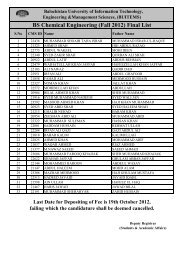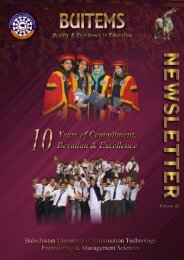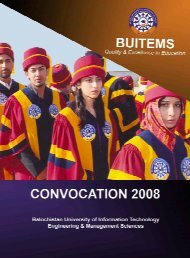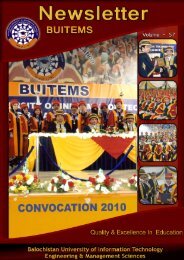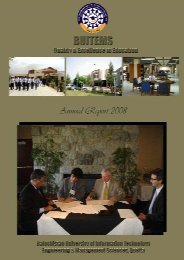BUITEMS
Research Journal - buitems
Research Journal - buitems
- No tags were found...
Create successful ePaper yourself
Turn your PDF publications into a flip-book with our unique Google optimized e-Paper software.
<strong>BUITEMS</strong><br />
Quality & Excellence in Education<br />
REDUCTION OF FIBRILLATION OF LYOCELL FABRIC IN CONTINUOUS DYEING<br />
CONCLUSION<br />
This study showed that regenerated<br />
cellulosic lyocell fiber has the technical<br />
problem of fibrillation generation during<br />
processing. Pre-treated lyocell fabric was<br />
found to have excellent absorbency. It was<br />
found in this study that the fibrillation problem<br />
increased as the lyocell fabric passed<br />
through further processes such as dyeing<br />
and washing. It was further concluded from<br />
the results obtained that the fibrillation can<br />
be controlled by the application of internal<br />
polymer cross-linking agent, which acts as a<br />
linking bridge between cellulosic polymer<br />
chains. After application of cross-linking<br />
agent, dye sites are disturbed because crosslinking<br />
agents attach at hydroxyl group of<br />
cellulose which is also the dye site for<br />
reactive dye. Thus, there are always chances<br />
for cross-linking agent to occupy the dye site<br />
and compete with reactive dye molecules.<br />
This may affect the color strength. fiber<br />
surface analysis showed that the surfaces of<br />
fibres were smoothened after application of<br />
cross-linking agents but shade depth and hue<br />
changed slightly. If pre-treatment cost of<br />
natural cellulosic fabrics and lyocell fabrics is<br />
compared for similar whiteness and<br />
absorbency level then it can be concluded<br />
that lyocell pre-treatment was economical.<br />
This is because of less processes and low<br />
chemical concentrations required for pretreatment<br />
of lyocell fabric. Further, lyocell<br />
fabric has higher absorbency, thus, having<br />
more dye-uptake and less dye wastage than<br />
the other cellulosic fibres. The lyocell fabrics<br />
attained peach-skin effect during wetprocessing,<br />
which is an advantageous factor<br />
over natural cotton and other regenerated<br />
cellulose fibres.<br />
REFERENCES<br />
• Bates I, Riesel, R and Renfrew AHM.<br />
(2008). Protection of LyocellFibers<br />
Against Fibrillation, Influence of Dyeing<br />
with Bis- Monochloro-s-Triazinyl Reactive<br />
Dyes. Colour Technology. 124: 252-<br />
258.<br />
• Bates I, Maudru E and Phillips DAS.<br />
(2004). Cross-linking Agents for the<br />
Protection of Lyocell against Fibrillation:<br />
Synthesis, Application and Technical<br />
Assessment of 2, 4-Diacrylamidobenzene<br />
Sulphonic Acid.<br />
Coloration Technology. Society of Dyers<br />
and Colourists. 120: 293- 300.<br />
• Chaudemanche C and Patrick N. (2010).<br />
Swelling and Dissolution Mechanism of<br />
Regenerated Lyocell Cellulose Fibers<br />
Springer, 18: 1-15.<br />
• Goswani P Taylor J and Patrick M.W.<br />
(2007), “Dyeing Behavior of Lyocell Fabric:<br />
Effect of Fibrillation”, Coloration<br />
Technology, Society of Dyers and<br />
Colourists, V. 123, September 2007,<br />
pp.387-393.<br />
• Martin James, Graveson Ian and Ashley<br />
S. (1998). Process For the<br />
Manufacturing Lyocell Fibers. United<br />
States Patent Number 5,725,821. 1-8.<br />
• Nicolai M, Nechwatal A and Mieck KP.<br />
(1996). Textile Cross-linking Reactions<br />
to Reduce the Fibrillation Tendency of<br />
LyocellFibers. Textile Research Journal.<br />
66: 575-580.<br />
• Patrick, M.B.E. (2001), Lyocell: The Production<br />
Process and Market Development,<br />
Regenerated Cellulose Fibers, 1st<br />
edition, wood head publishing limited,<br />
Cambridge England, pp.62-86.<br />
• Renfrew AHM and Philips DAS. (2003).<br />
Protection of Lyocell Fibers Against Fibrillation:<br />
Mode of Action of Cross-linking Agent<br />
2, 4 - Dichloro-6-(Sulphatoethylsulphonyl)<br />
Anilino-s-Triazine. Colouration Technology.<br />
119: 116-120.<br />
• Rouette HK. (2000). Encyclopedia of<br />
Textile Finishing, New York, Springer<br />
Science, Business Media, L.L.C, pp.<br />
130- 156.<br />
• Wang Young- Soo, Koo Won-Mi and Kim<br />
H. (2003).Preparation and Properties of<br />
New Regenerated Cellulose Fibers.<br />
Textile Research Journal. 1-9.<br />
37



